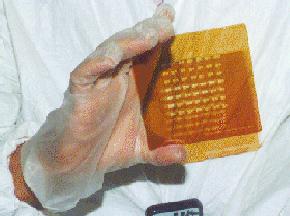
Processor and microchip giant Intel is taking its motto 'Intel inside' quite seriously, to the effect that it is currently researching and developing a microchip that is placed inside the body, and detects accurately more than 50 diseases. In collaboration with Stanford University School of Medicine, Intel's Biosystem's group, headed by Dr. Madhu Verma, is developing a microchip, the types used in computers, which analyzes various disease related proteins and peptide chains present in the blood, to diagnose diseases.
The chip is embedded inside the arm, and in contact with blood, it analyzes the peptides , with its surface itself covered with around 9000 peptides, and the data is then fed into a computer, along with gauging the related possible symptoms. These peptides were embedded on the silicon chip the same way as normal chips are done with, using photo-lithography technique.
Before joining hands with Intel, Stanford researchers were trying glass to stick peptides on and do the detection process, after which Intel came in. Earlier skeptical on its success, it soon turned out much better than the earlier one, with silicon having advantage over glass being relatively non sticky towards other peptides, as well as providing way to embed peptides more closely, and thus save more space. Use of microchips always gives a chance of improvement in the detection system.“If we couple these Intel arrays with an electronic detection method, for example, we could have real-time sensing over a period of minutes,” said Dr.P.J. Ultz, Associate Professor at Stanford.
In the research program, it was tested on the disease Lupus , which is a highly variant auto immune disorder. Leaving the technicality aside, with the help of the chip using various amino acid sequence combinations, they found out the sequence that antibodies look for, as well as the modifications to find out specific binding sites.
This will make way for better targeted drugs, by manipulating and seeing results accurately at the amino acid where required. Researchers are now looking to use this to design better influenza vaccines with better immune response.
Research is being done so as to embedded an Integrated Circuit inside the chip, so as to make it function as a mini computer itself, and conclude while present inside. Also it is being tried to make it connect to a smartphone or any other computing device wirelessly. Although clinical trials will take another 2 years to complete, but its success could pave way to better and early diagnosis, even in the field, ensuring better chance of treatment for patients.
Source : Stanford Medical University

No comments:
Post a Comment